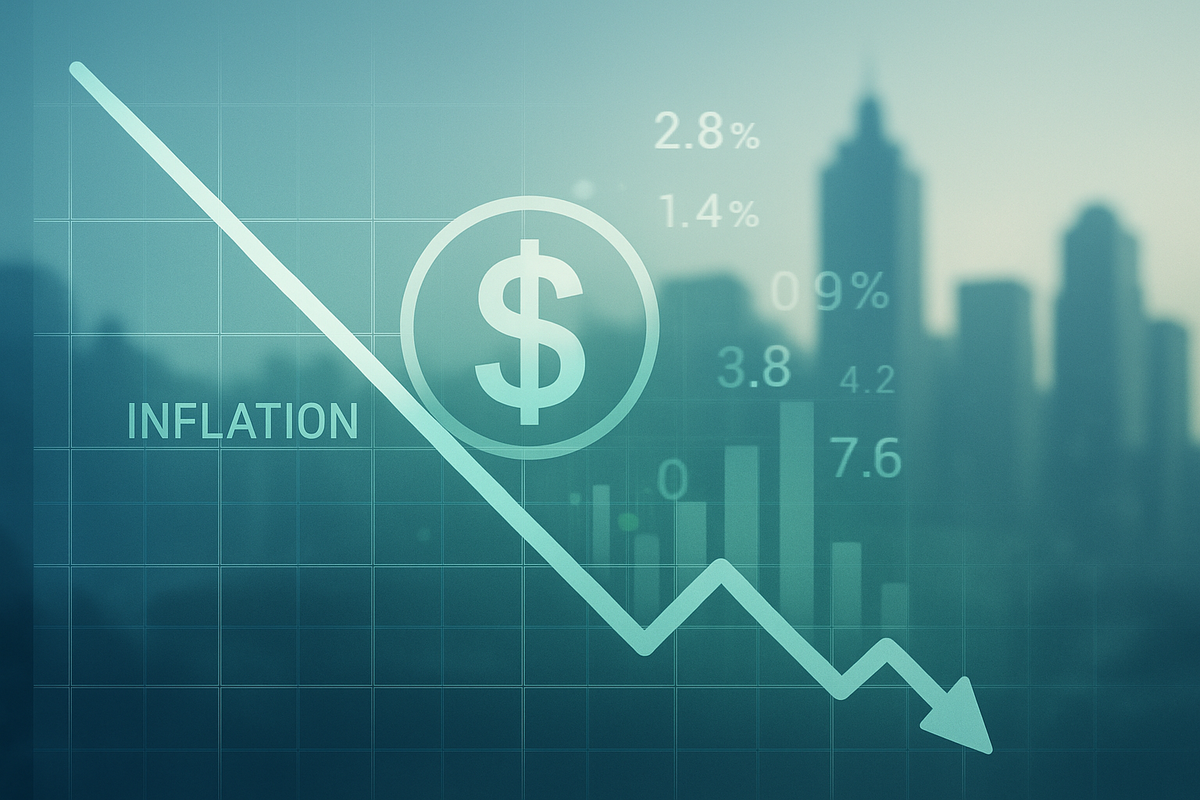
The financial markets are abuzz with heightened expectations for a Federal Reserve interest rate cut in September, with probabilities soaring to an overwhelming 96%. This dramatic shift in sentiment comes on the heels of recent inflation data, particularly the July Consumer Price Index (CPI) report, which has largely been interpreted as a green light for the central bank to ease its monetary policy. The increased likelihood of a rate cut signals a significant pivot in the Fed's approach, moving from a hawkish stance to one more accommodative, with profound implications for investors, businesses, and the broader economy.
Inflation Tamed: The Data Driving the Fed's Hand
The market's conviction in a September rate cut has solidified rapidly, with the probability jumping from approximately 86% to 96% in a short span. This significant re-pricing of expectations is primarily attributed to the latest economic indicators, which suggest a cooling economy and moderating inflation.
The most influential piece of data was the July Consumer Price Index (CPI) report, released on August 12, 2025. The headline CPI rose a modest 0.2% month-over-month, a deceleration from June's 0.3% increase and aligning with economists' forecasts. On a year-over-year basis, headline CPI held steady at 2.7% in July, matching June's figure and slightly undercutting the consensus forecast of 2.8%. This "tame" inflation reading defied earlier concerns about persistent price pressures. While core CPI, which excludes volatile food and energy prices, saw a slight uptick to 0.3% month-over-month and 3.1% year-over-year, the overall report was largely interpreted as a sign that inflation is under control and moving closer to the Fed's 2% target.
Adding to the narrative of a softening economy was a weaker-than-expected employment report for July, coupled with significant downward revisions to job figures for May and June. This data indicated a cooling labor market, a key factor the Federal Reserve considers in its dual mandate of price stability and maximum employment. The combination of moderating inflation and a less robust job market has led market participants to believe the Fed now has ample room to cut rates without reigniting inflationary pressures, thereby supporting economic growth. This shift marks a pivotal moment, as the central bank appears poised to prioritize economic stimulus after a prolonged period of tightening.
Winners and Losers: Navigating the Rate Cut Landscape
A Federal Reserve interest rate cut typically creates a distinct set of winners and losers across various sectors of the economy. The impending September cut is expected to particularly benefit interest-rate-sensitive industries, while potentially posing challenges for others.
Winners are likely to include sectors that thrive on lower borrowing costs and increased consumer spending. Housing and Real Estate are prime beneficiaries, as lower mortgage rates make homeownership more affordable, stimulating demand. Companies like Lennar Corporation (NYSE: LEN) and D.R. Horton, Inc. (NYSE: DHI), major homebuilders, could see increased sales and profitability. Similarly, Financials, particularly regional banks and mortgage lenders, could experience a boost in loan demand, though their net interest margins might face some compression. Consumer Discretionary companies, such as retailers and automotive manufacturers, could also see a lift as consumers have more disposable income due to lower debt servicing costs. Companies like Amazon.com, Inc. (NASDAQ: AMZN) and Tesla, Inc. (NASDAQ: TSLA) might benefit from increased consumer confidence and spending. Furthermore, Growth Stocks and Technology Companies often perform well in a lower-rate environment, as their future earnings are discounted at a lower rate, making their valuations more attractive. Tech giants like Microsoft Corporation (NASDAQ: MSFT) and Apple Inc. (NASDAQ: AAPL) could see renewed investor interest.
Conversely, Losers in a rate-cutting environment often include sectors that have benefited from higher rates or rely on a strong dollar. Banks with significant net interest margin exposure could see their profitability squeezed as the spread between what they earn on loans and what they pay on deposits narrows. While overall loan demand might increase, the immediate impact on margins could be negative for some. Value Stocks, which often perform well when interest rates are rising, might see a rotation out of their favor as growth stocks become more appealing. Utilities and Consumer Staples, often considered bond proxies due to their stable dividends, might become less attractive as bond yields fall, making their dividends less competitive. Companies like NextEra Energy, Inc. (NYSE: NEE) or The Coca-Cola Company (NYSE: KO) might experience some outflow of capital. Additionally, a weaker dollar, which often accompanies rate cuts, could negatively impact exporters if their goods become more expensive overseas, though it could benefit companies with significant international operations that translate foreign earnings back into a stronger dollar.
Industry Impact and Broader Implications
The Federal Reserve's likely September rate cut is not merely a technical adjustment; it represents a significant shift in monetary policy with far-reaching implications for various industries and the broader economic landscape. This move fits into a broader global trend where several central banks are contemplating or have already initiated rate cuts in response to moderating inflation and slowing economic growth.
The most immediate ripple effect will be felt in the credit markets. Lower benchmark rates will translate into reduced borrowing costs for businesses and consumers alike. This could stimulate investment in capital projects, encourage business expansion, and make consumer loans, such as auto loans and credit card debt, more affordable. Industries heavily reliant on financing, such as manufacturing, construction, and transportation, could see a resurgence in activity. For instance, a company like Caterpillar Inc. (NYSE: CAT), a major manufacturer of construction and mining equipment, could see increased demand for its products as construction projects become more viable.
From a regulatory and policy perspective, a rate cut signals the Fed's confidence in its ability to manage inflation while supporting economic growth. It could also alleviate pressure on the U.S. Treasury, as the cost of servicing the national debt would decrease. Historically, periods of rate cuts have often been associated with efforts to avert or mitigate economic downturns, or to provide stimulus during periods of low inflation. The current situation, with inflation moderating but still above the Fed's target, presents a nuanced scenario. Comparisons can be drawn to periods in the early 2000s or post-2008 financial crisis, where the Fed aggressively cut rates to stimulate the economy. However, the current economic backdrop, characterized by a relatively strong labor market despite recent softening, differs from those more severe downturns, suggesting a more measured approach to easing.
The potential for a weaker U.S. dollar, a common consequence of rate cuts, could also have significant implications. While it might make U.S. exports more competitive, it could also increase the cost of imports, potentially reigniting some inflationary pressures down the line. Multinational corporations like Procter & Gamble Co. (NYSE: PG) or Johnson & Johnson (NYSE: JNJ), with substantial international revenues, could see their foreign earnings translate into more dollars, boosting their reported profits. Conversely, companies heavily reliant on imported raw materials might face higher input costs.
What Comes Next: Navigating the Easing Cycle
The impending September rate cut marks the likely beginning of an easing cycle for the Federal Reserve, ushering in a new phase for financial markets and the economy. Understanding what comes next is crucial for investors and businesses to adapt their strategies.
In the short-term, the immediate aftermath of a rate cut is often characterized by a "relief rally" in equity markets, particularly for growth and technology stocks, as lower discount rates boost their valuations. Bond yields are also likely to fall further, increasing bond prices. Companies that have been holding off on capital expenditures due to high borrowing costs may now accelerate their investment plans, leading to increased business activity. Consumers, facing lower interest rates on loans and mortgages, might increase their spending, providing a boost to retail and services sectors. However, the market will closely watch for the Fed's forward guidance – whether this is a one-off adjustment or the first in a series of cuts.
In the long-term, the trajectory of the easing cycle will depend heavily on incoming economic data, particularly inflation and employment figures. If inflation continues to trend downwards towards the Fed's 2% target and the labor market shows further signs of cooling, more rate cuts could follow. This could lead to a sustained period of lower interest rates, potentially fueling a bull market in equities and a robust housing market. However, if inflation proves stickier than anticipated, or if the economy shows signs of overheating due to the stimulus, the Fed might pause or even reverse course, leading to market volatility.
Potential strategic pivots for businesses include re-evaluating debt structures to take advantage of lower borrowing costs, investing in expansion, and potentially increasing dividends or share buybacks. For investors, opportunities may emerge in sectors that are highly sensitive to interest rates, such as real estate investment trusts (REITs) and utilities, as well as in companies with strong growth prospects that benefit from a lower cost of capital. Challenges could include navigating potential currency fluctuations and adjusting portfolios to a lower-yield environment for fixed-income investments. Scenarios range from a "soft landing" where the economy avoids a recession and inflation gradually returns to target, to a more aggressive easing cycle if economic growth falters significantly.
Conclusion: A New Chapter for Monetary Policy
The Federal Reserve's imminent September rate cut, now a near certainty with a 96% probability, marks a pivotal moment in monetary policy. The key takeaway is that recent favorable inflation data, particularly the July CPI report, combined with a softening labor market, has provided the central bank with the necessary justification to begin easing its restrictive stance. This shift signals a move towards supporting economic growth after a prolonged period focused on taming inflation.
For the market moving forward, this likely marks the beginning of an easing cycle. Investors should anticipate continued volatility as the market digests each new piece of economic data and the Fed's subsequent actions. The immediate impact is expected to be positive for interest-rate-sensitive sectors like housing, technology, and growth stocks, while potentially posing challenges for traditional banking margins and some value-oriented investments. The broader economy could see a boost from lower borrowing costs, stimulating investment and consumer spending.
What investors should watch for in the coming months includes the August PCE data (the Fed's preferred inflation gauge), subsequent CPI reports, and, crucially, the Fed's commentary and dot plot projections for future rate paths. Any signs of inflation re-accelerating or the labor market tightening unexpectedly could cause the Fed to reconsider its easing trajectory. Conversely, further signs of economic deceleration could prompt more aggressive cuts. The lasting impact of this policy pivot will depend on its ability to guide the economy to a "soft landing" – achieving price stability without triggering a recession – a delicate balancing act that will define the financial landscape for the foreseeable future.





